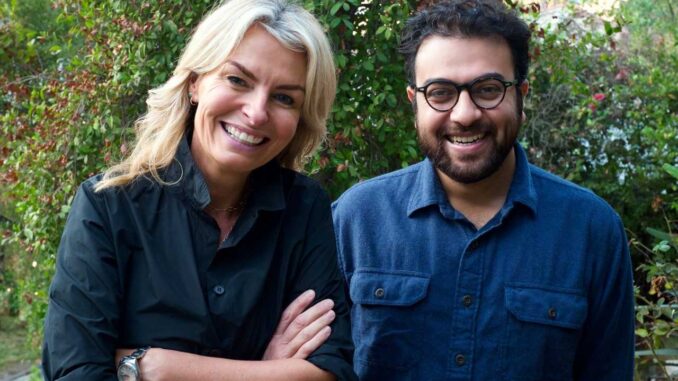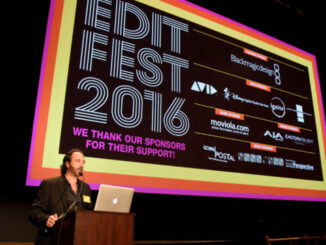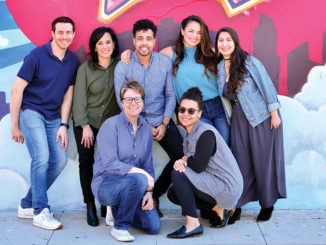
by Rob Feld
Tracey Wadmore-Smith and Shayar Bhansali are a testament to the power of mentorship in editing. What began as a mentor/mentee relationship after Bhansali graduated from AFI has continued as an equal partnership on multiple projects.
Their latest is “I’m Your Woman,” their second collaboration with director Julia Hart, which is framed as a female take on 1970s crime dramas. Suburban housewife Jean (Rachel Brosnahan), is left on her own with an infant when her criminal husband Eddie (Bill Heck) goes on the run. Whisked away to a safe house but given no information by Eddie’s associate, Cal (Arinzé Kene), she waits for safety and Eddie’s return. A series of complications sends Jean hurtling into the criminal underworld.
Wadmore-Smith grew up in the U.K. and found photography in art school. Deciding to pursue cinematography, she found a PA job at a tiny film production company based in London called Picture Partnership Productions, later Carnival Films. She immediately gravitated to the basement edit suite, watching the assistant editors sync dailies while the editor cut on the Steinbeck. “When the dailies were ready,” she recalls, “I would put them on a dolly and run them though the wet streets of Soho to a dingy back alley, with a crumbling old building and an open doorway. I would carry the dailies up the six flights of narrow stairs to a gentleman who would code them—we called it rubber numbering.”

Bhansali found editing during his undergraduate years in Mumbai while studying psychology. His free time was spent helping his older brother and his friends make documentaries. Increasingly, he gravitated to sifting through footage at the office. “I found that part of the process to be fascinating, similar to writing or putting a puzzle together,” he says. Eventually he met Bollywood editor Khushboo Agarwal Raj, who mentored him before he moved to L.A. to study film editing at AFI.
Cinemontage: Did you have a key mentor and if so, what was a key lesson you learned from your apprenticeship experience?
Bhansali: Absolutely, and I couldn’t be more thrilled to be doing this interview with her! Tracey has this unique ability to connect with and understand the people around her. It’s empathy, which is an incredibly important part of being an editor. It forms the basis for our understanding of the story and actors’ performances, and the relationships we have with our directors and the rest of the editorial/post teams. If there’s any key lesson I’ve taken from her, it’s a willingness and ability to work well with others.
What sort of pre-production discussions do you like to have with a director, and what were they like on “I’m Your Woman”?
Wadmore-Smith: Julia and Jordan shared the script for “I’m Your Woman” with us while we were completing post-production on “Stargirl.” We talked about specific references and the general ideas behind where the story came from. The film is set in the ‘70s, and we talked about music that Julia had in mind and some of the inspiration for that. We talked a little about Michael Mann’s “Thief,” specifically, and other films from the period and the genre. I also wanted to understand how Julia wanted the film to feel in relation to the time period, and these discussions helped us with everything from music choices to the kind of sound design we played with during editorial.
Bhansali: I love reading scripts early if I have a relationship with the filmmaker because it allows us to start discussions about the film and get a much more intimate look at what the director’s intentions are before production. Aside from specific ideas about transitions and style that we might discuss, I love being able to get into things like character arcs and motivations. We will usually also talk about music or any ideas the director might have with regard to the score, and all of this with the intention that we are more aligned with the director’s vision by the time production starts.
“I’m Your Woman” is your second collaboration with director Julia Hart and with each other. Can you describe your collaborative process on these films and how it developed?
Bhansali: Tracey and I worked together on a couple projects where I was her assistant before she invited me to edit “Stargirl” with her. We had a great experience working together with Julia Hart (and writer/producer Jordan Horowitz), and they asked us to join them as co-editors on “I’m Your Woman.” “Stargirl” was our first collaboration as co-editors, and we refined a lot of what our process was like on that film with “I’m Your Woman.” Since we’ve worked together for a few years and have an established level of trust, we approach every scene of the film together as a team. During production, we usually spend the first part of our mornings sitting in the same room watching dailies together (and drinking copious amounts of tea). This is where we discuss ideas and start forming some sense of how we think a scene will come together. We’ll talk about performance for the most part, and then split up the scenes for the day and go cut them separately. By the early evening, we’ll reconvene in one room, watch the work we’ve done and go over notes, at which point we usually switch places so that the other person can sit on the Avid for notes. It ensures that both of us are comfortable with the footage from any given scene, and it allows us to look at the work and critique it objectively. Our intention is to make sure that both of us can jump on any scene with the director when she comes in and be fully aware of what all the options and material look like. It also creates an environment that is open to ideas from the rest of the editorial team, and we love having them get involved during production when they have the time, not to mention the fact that it helps us enjoy the process as a team.
What was the great challenge of “I’m Your Woman?”
Wadmore-Smith: Creating and maintaining suspense, and the way in which the film handled tone. These aren’t necessarily unique, but tone with a film like this needed careful deliberation and we were conscious about the choices we made for our point of view, and how that relationship balanced with rhythm.
Bhansali: Threading that fine line of suspense and anticipation with the satisfaction of learning things with our central character. We like to think of this as a positive “challenge” with a project like this, because it’s one of the things we love about watching films that slowly and deliberately pull you in so close that you’re completely lost in the characters, and where you might think that you are actually living the moments through with them beside you.
Cinemontage: What’s the first thing you’re looking for as you review footage? Performance?
Wadmore-Smith: Performance, yes. I’m looking less at how it might cut together and more for an overall reaction to the performance itself, and how I feel it plays in context with the rest of the material we have received so far. During production, you might have a scene broken up by filming location and have part of it shot in the first week of the schedule, and the rest of it a couple of weeks later. On reviewing this footage, we’re always looking for the connective thread in performance that will help the viewer believe this “cheat,” and in a more general sense, we are always reviewing footage with the benefit of having this “context” easily available to us in the form of dailies from the rest of production.
Bhansali: I like to review footage with the hope of being captured by the performances in the way I hope a viewer will be while watching the film—we’re always looking for honesty in the sense of how well the performance captures the intention behind any scene, and how it fits in with the overall motivations of the character. For example, when we see a take of Jean talking with Cal about where her husband is and what is going on, we want to feel Jean’s isolation and her grasping for any bits of information. We want the audience to feel this way when the scene is constructed, and while this might be a small moment in the character’s journey, it helps us connect with the actors on screen in a way that makes us invested in their hopes and challenges.
What do you think is key to maintaining a career?
Wadmore-Smith: I think a number of things play into maintaining a career. For me it has become vitally important that I work with people I respect, appreciate, and enjoy. Unfortunately, being an editor isn’t just about being creative, but also having the patience and diplomacy to handle the inevitable politics. I’ve found it helpful to have some acting abilities when navigating this particular area. My general rule of career maintenance is to believe in myself, believe in the story, fight to do what’s best for the integrity of the story and do it with patience, creativity, and grace.
Bhansali: I think it helps to have mentors that are willing to support you, and it’s a blessing that the editing community takes that seriously. I’ve been lucky to have been a mentee with the ACE Diversity Mentorship program and have found a strong support system within that and other groups. As an editor, you end up spending a long time with any project you do and picking the right ones is an important part of what shapes your career. What that means is different for everybody, but I am definitely of the opinion that you want to try and work with good people, people that want to grow with you and respect you and your talent in a way that allows you to flourish in the job.






